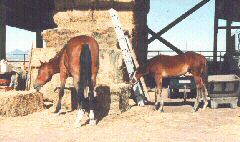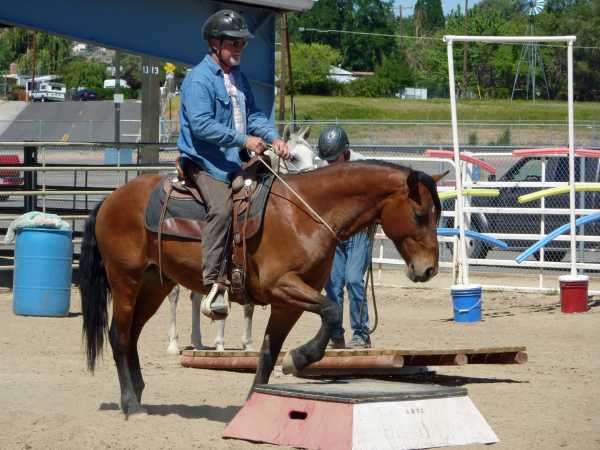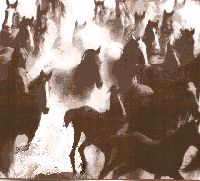|
Horses are highly developed and specialized herd animals. Their ability
to survive and flourish in a wide variety of wild environments in spite of
predators and hardship is based in great part on their ability to learn.
The trainer who understands the learning habits of horses will have much
less difficulty teaching horses how to respond in the human environment.
Additionally, when the trainer or handler is aware of the learning
characteristics of the horse, the process will go much faster and the horse
will be less stressed.
So, how do horses learn? In this information sheet we will discuss four
basic elements, the "point of release", visual learning, patterning and
herd hierarchical pressure.
Horses are curious and most like to explore their environment, however
they don't have acute vision and virtually no depth perception. Thus, when
confronted with new objects, they tend to study them through a series of
advances and retreats, eventually either giving up on the object or becoming
confident enough to actually smell it. If the object doesn't move or
startle them, the curious horse will reach a point where he feels a release
of tension and it is at this point the horse has learned that the object is
"OK". (The horse may also flee the object, with the point of release may
be when he has reached a sufficient distance away to feel OK.)
When a young horse is cutting up one of the herd elders may discipline
him by running him around. At the moment the younger horse displays
appropriate behavior, the elder horse stops her pursuit, "releasing" the
youngster and in effect teaching him how to behave.

|
The point of release is a very effective teaching tool. One can set up
stimuli, introducing the horse to something new that he may be frightened
of, and manage the introduction until the horse reaches his own point of
release. Or, one could be putting pressure on a horse (as in longeing),
until that moment that the horse improves his behavior, then release him to
reinforce the good behavior. Similarly, a young horse might not stand for
the shoer. When the horse misbehaves, pressure is applied by sending him
out to work on longe for a short period, yet he is "released" when he is
willing to stand quietly next to the shoer.
|
It's not pressure or curiosity which cements the learning process, it is
the timing of that point of release where either the horse's internal
instincts (such as when exploring something scary), or that of the handler,
send a message to the horse's brain which says, "That's it!"
|
Horses learn from each other. They see a horse do something and they
will emulate it. We have paddle waterers in our pastures and paddocks. In
the paddocks, we have to teach new horses how to use the waterers. In the
pastures, where they see other horses using them and the new horses take
to them right away. We put a barrel with a float valve in one of the
pastures. After a half day the animals still wouldn't get within 50 feet
of it. We tossed a couple of apples into it and one of the braver souls
finally tiptoed over to check out the apples. Within a couple of minutes
she was "bobbing" for the apples and the others immediately came up and
pushed her out of the way.
Horses may also transfer this learning element to humans. When it is
quiet, we let horses out to graze about in the stable, which is just outside
our back yard. The gate to our yard is within sight of Sharon's quarter
horse, Mikey. Mikey watched a new chain link fence being installed
including a gate with a flip-type fork latch. A few days after the fence
was in, we let Mikey out to graze. He simply walked over to the gate,
nosed the fork up where he'd seen us grabbing it, and went into the
yard.
|

Marcy would run from the farrier until she saw her mother standing quietly.

|
CJ Showing Scooter around the barn

|
We've had young horses absolutely panicked over some object in the barn
or stable. When their owners would lean down and investigate these
objects, including sniffing them, at least nine out of ten times a big
horse nose would soon butt in to investigate the object, just as they would have with an older, "mentor" horse.
|
|
Horses learn from repetition. If they do something repeatedly, it will
become a repetitive habit. If you let a horse walk off as you mount it a
few times in a row, the horse will likely develop it as a habitual pattern.
If the horse gets a can of grain each time after longeing, then he's going
to be cranky the first time you break that pattern by throwing on a saddle
and attempting to ride. With Mikey, Sharon cannot perform a maneuver in
the arena at the same place two times in a row or he'll anticipate and
expect to do it the third time Sharon gets there.
An example of a negative pattern is blindly rewarding with treats; the horse
becomes a circus animal expecting a tidbit for every good behavior. An
example of a positive pattern is whenever we leave the arena, we will open
and close the gate from horseback before we proceed out on our "reward ride" or give the horse a grazing turnout. We do this from the first day a
young horse is ridden in the arena. The trainer / handler has to be aware
of patterning and avoid establishing negative patterns and encourage positive
ones.
Another method of patterning involves operant conditioning, often referred
to as "Clicker Training."
Clicker training involves treats but differs from just handing out goodies due to the fact that the horse
is patterned into a learning game and no treats are given unless a marker is sounded
(the click) which signifies that the horse has completed the correct behavior. This
all sounds pretty far fetched but most horses catch on to clicker training really fast and
work hard to figure out all sorts of behaviors.
|
Dina schooling young Corey

This is Max, a clicker trained
6YO former wild stallion in his second week
of gentling. His front foot is on the shoeing
stand with no lead rope attached

|
The reason clicker training doesn't create a horse that constantly mugs the handler for goodies is that a pattern has been established at the very beginning of the training that the only time a goodie is produced is after a click is sounded which is only associated with a correct behavior (or a good attempt at a correct behavior.) The trainer can stand with a bowl of grain or a handful of carrots within sight and reach of the horse and the horse will typically ignore the treats and try to find the correct behavior. Spoiled horses that will mug people for treats typically don't mug during clicker training. They will, however, resume their undesirable behavior outside of the training environment if their owners or others continue to spoil them after the sessions are completed.
|
|
HERD HIERARCHICAL PRESSURE
|
We have left this element until last since it is the one which is most
abused.
|
We all hear some trainers say "You've got to make them do (such and
such)," or "You have to be tough with them." Well, you can make a horse do
many things, but it's certainly not using all of the tools in your toolbox.
That same cowboy probably wouldn't attempt to build a barn with just a
hammer. He'd probably need at minimum a saw, a tape measure and a level to
do the job efficiently. He might be able to throw something together
without these other tools, but what kind of quality would he get?
Some of these guys can get away with it because they are very good
riders, have great reaction times, and a few even enjoy getting pitched on
the ground. As for me, I'd prefer to use my dominance only as much as
necessary and develop the other elements of horse learning "in balance".
So in this context, here's what hierarchical pressure is all about.
|


|

|
All horse bands have some form of social order. Every horse in the herd
has a ranking from top to bottom. This ranking is dynamic so as animals
leave or rejoin the band, gaps in the order are filled or the returning
horse assumes his former position, or perhaps finds himself in a new position in the order.
When a new horse (or human) is introduced into the equation, he must
establish his ranking. This is seldom done by force, although force can be
used between close-ranking contenders for the same spot in the order.
|
For the most part, the horse which displays the greatest leadership presence
takes the top spot and earns the most respect, and sometimes this can be
the smallest horse in the group.
I have absolutely no desire to engage in a physical contest with any
horse. Most outweigh me by at least seven times, they are taller and can
run faster. I'd much rather display my knowledge of herd communication and
establish myself clearly as the leader. The easiest way to accomplish this
is in the round corral, the methods of which are discussed in other
training topics.
As the hierarchical leader, the horse is going to respect my space, will
naturally yield to my pressure, will naturally watch for and respond to my
cues and aids, and will want to earn my respect in response. If I ask the
horse to follow me, he will whether on or off lead. If I signal to the
horse that some upsetting stimulus is OK, he will accept my judgement. If
I ask him to go off with just the wave of my hand, he'll make a snappy and
respectful departure. The only hitch is, I have to be diligent myself to
never betray that trust and following which I have solicited from my
horse.
|
| |
In a nutshell, here's how it all works. You present yourself to the horse.
He is curious about you. Through good horsemanship techniques you
establish yourself as a leader. You start to set up problems for your
horse to solve (training the horse). The instant he gets the right idea,
you release him so he will get the association. As the problems presented
get more complex, you set it up so that your horse can see other horses
doing the activities correctly, or in some cases you show the horse how to
do something or that an upsetting stimulus is OK. You reinforce good
habits by establishing repetitive patterns (but avoid overdoing this and
boring your horse to sleep), and you avoid repetitive situations which
reinforce negative patterns (bad habits).
|

|
The concept is really that simple. It's the conversion from theory to
practical application which takes some thought and practice, but if you
understand why certain things work the way that they do, you'll
figure out how to get the results that you want.
Mustang Falcon showing off his stuff at the 2008 Nevada Day Parade.

Trooper (5 YO BLM mustang) off the range for less than a year at the WHB Expo.

(More specific details regarding these concepts are presented in the other
topics in the training section.)
How Sensitive are Horses to Their Handlers?
Check out the story of Clever Hans
Press "Back" to return to the page that brought you here
KBR Horse Training Information, © 1997
Lamm's Kickin' Back Ranch and Willis & Sharon Lamm. All rights reserved. Duplication of any of this material for commercial use is prohibited without express written permission. This prohibition is not intended to extend to personal non-commercial use, including sharing with others for safety and learning purposes, provided this copyright notice is attached.
Email us to submit comments or
request reproduction permission.
|













